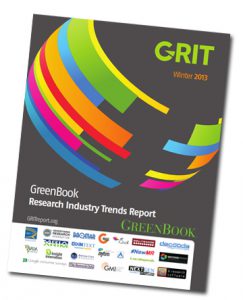A Round-Up of the 2014 GRIT Report, Part 3
 The Green Book Guide for Buyers of Marketing Research publishes an annual report based on a survey of research clients and suppliers. The report, known as the GRIT (Greenbook Research Industry Trends) Report, draws on input from over 3000 research professionals, including those from Canada’s Marketing Research and Intelligence Association, to provide an overview of current research industry trends. While the majority of the report pertains to industry activity in the U.S., many of the trends apply to the Canadian industry as well. Here is a synopsis some sections of the 2014 GRIT report, used as a launch pad for my own observations.
The Green Book Guide for Buyers of Marketing Research publishes an annual report based on a survey of research clients and suppliers. The report, known as the GRIT (Greenbook Research Industry Trends) Report, draws on input from over 3000 research professionals, including those from Canada’s Marketing Research and Intelligence Association, to provide an overview of current research industry trends. While the majority of the report pertains to industry activity in the U.S., many of the trends apply to the Canadian industry as well. Here is a synopsis some sections of the 2014 GRIT report, used as a launch pad for my own observations.
It Ain’t What It Used To Be
For years, marketing research companies operated primarily through mail, then telephone surveys along with interview and focus group research with occasional ‘fringe’ approaches to keep things interesting. These traditional approaches are still used, much of the time with good results. They won’t disappear any time soon. And, of course, there is no replacement for face-to-face communication in a research process.
However, the days of the majority, never mind a ‘representative sample’ of the population volunteering valuable opinions by phone (and certainly by mail) are virtually over. With the passage of time, consumer behaviours and expectations are not what they were; technology has evolved; and approaches to marketing research have changed alongside. Consider:
- A growing proportion of the population makes regular use of tablet computers and smartphones, and channels of media use are now differentiated by age and interest group.
- Online communication is so much the norm that we are suffocating in SPAM; communications must be selectively targeted.
- Consumers are, more and more, shopping and buying online; marketing is done more and more online.
- Products, services and consumer expectations are more diverse; marketing has had to become more sophisticated.
- Time pressures have increased all-round and it’s harder than ever to engage consumers without distraction; consumer research may provide both information and entertainment.
- Organizations demand more return from their outside research dollar and more impactful results with less funding; research clients and their suppliers thus seek innovative approaches with greater applied value and shorter delivery times.
Along with evolving consumer behaviour then, changes in research approaches are being driven both by advances in technology and in shrinking client research budgets.
New Approaches Taken Root
What are the most promising and productive new research approaches being adopted in the research community? The following are being used or considered by, on average, about one-third of research clients and suppliers.
Online Communities – panels of pre-screened respondents, typically recruited and maintained specifically for a client among its current or potential customers. Each respondent agrees to participate in a series of research inquiries, so almost becoming part of the product development and marketing team over time.
Mobile Research – adapting survey and  qualitative methodologies for completion by respondents using their mobile devices. This often relies on research “bites” over time, but allows for real time data return and photo/ethnographical data collection — i.e., the ability to monitor behaviour rather than relying on respondents to self-report. It is also a natural approach for iterative research, where researchers can follow up on input from individual respondents to gain greater depth and textural insight.
qualitative methodologies for completion by respondents using their mobile devices. This often relies on research “bites” over time, but allows for real time data return and photo/ethnographical data collection — i.e., the ability to monitor behaviour rather than relying on respondents to self-report. It is also a natural approach for iterative research, where researchers can follow up on input from individual respondents to gain greater depth and textural insight.
Text / Social Media Analytics – using sophisticated computer applications to collect relevant data from the Internet and other large information sources to perform ‘Big Data’ analysis. This approach is commonly sought to identify/predict early trends. However, downsides to Big Data and social media modelling are: 1) they usually require a major financial investment, and 2) they often create issues around privacy, data sharing and information security. Further, these approaches do not generally allow for direct two-way engagement with the population of interest.
Alternative approaches – If that’s not enough, try investigating some of these alternate approaches (in order of current usage):
- Eye Tracking
- Micro-surveys
- Research Gamification
- Prediction Markets
- Virtual Environments/Virtual Reality
- Facial analysis
- Crowdsourcing
- Biometric Response
- Neuromarketing
- Behavioural Economics Models
- Wearables Based Research
Yes, along with evolving consumer behaviour then, changes in research approaches are being driven both by advances in technology and in shrinking client research budgets. With more new platforms to choose from, having an experienced advisor to guide you through these decisions will become more important than ever.
Are you seeking support with your market research? Please click here to learn more about Tenato’s market research services.

